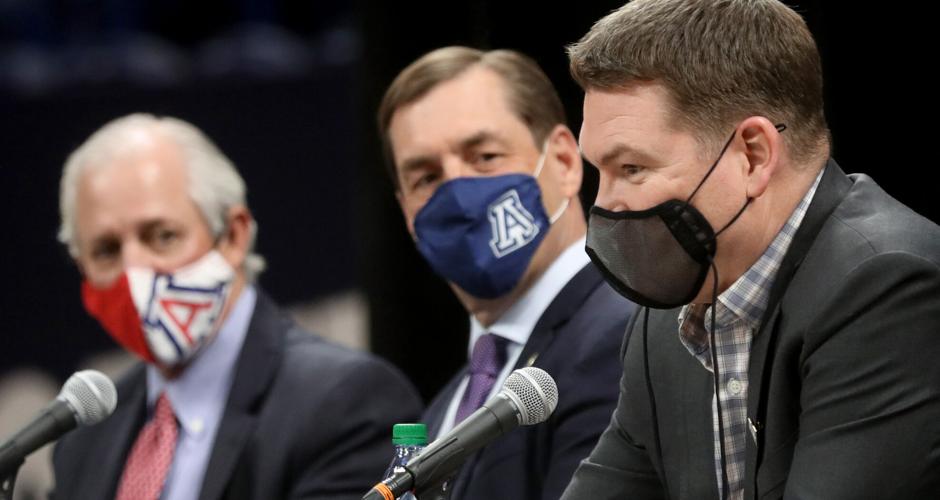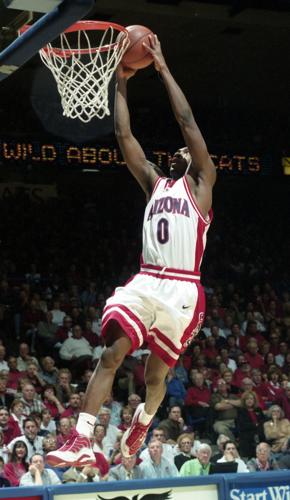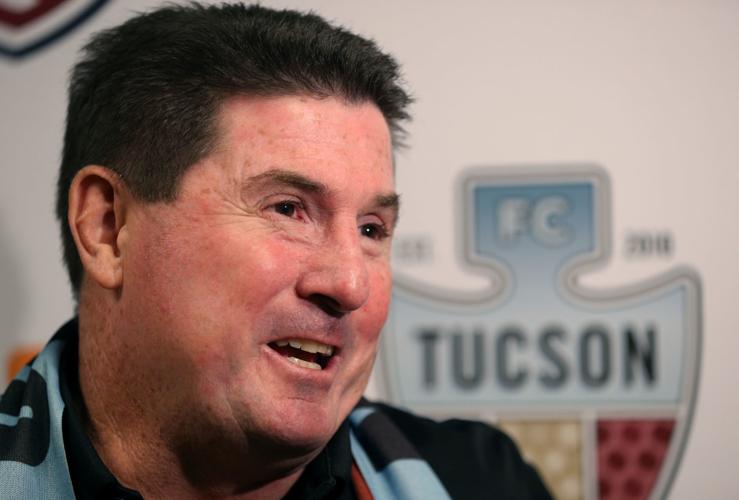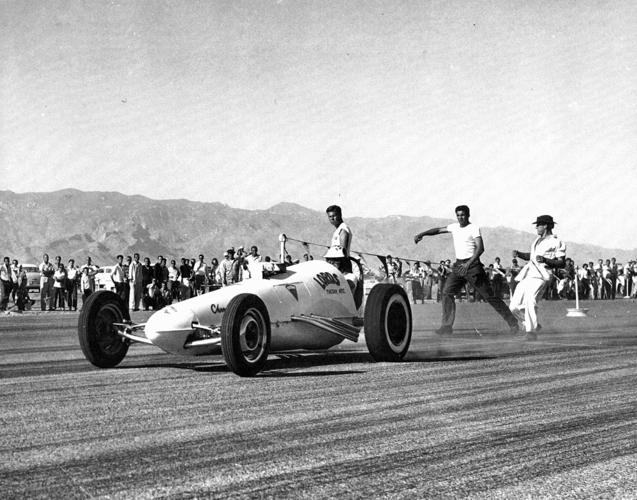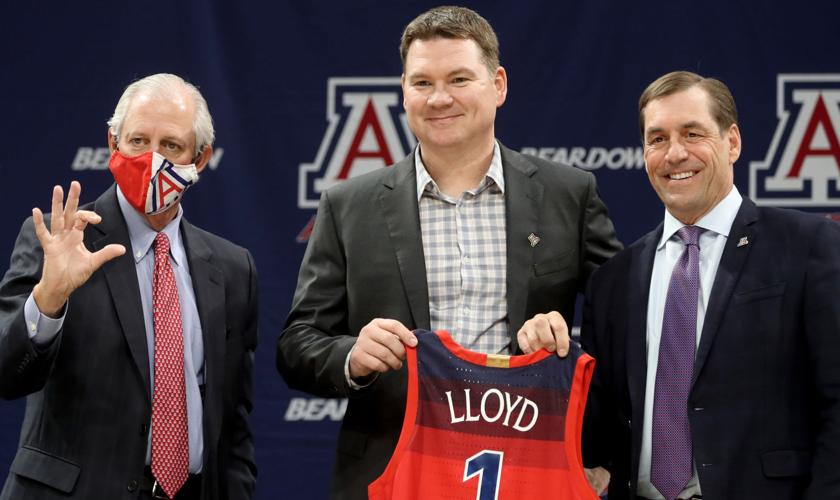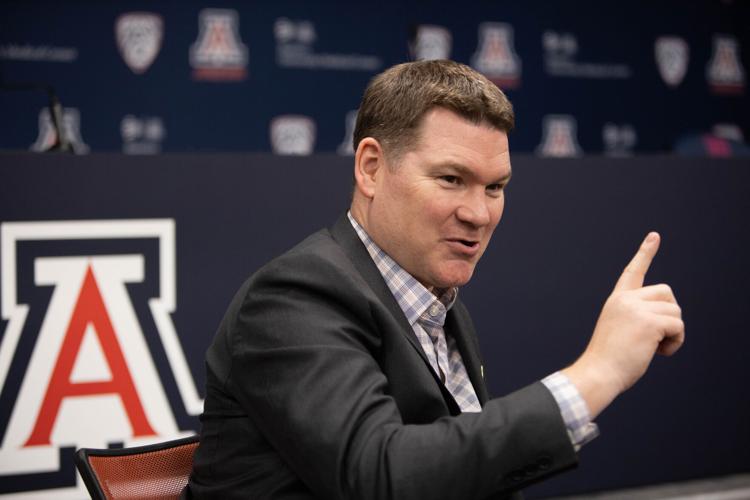One former Kansas sports information director compares Arizona's hiring of Tommy Lloyd to Kansas and Roy Williams in 1988. Plus, a look at the current success of Southern Arizona junior-college programs, and what Dylan Anderson's commitment to the Wildcats means for the UA.
After winning the NCAA basketball championship in 1988, Kansas coach Larry Brown left to become head coach of the San Antonio Spurs. He left behind more than the nets the Jayhawks cut down at the Final Four.
He left behind an in-process NCAA investigation.
The NCAA was in the final stages of investigating KU’s basketball program for impermissible recruiting benefits and lack of institutional control.
Sound familiar? Hiring a replacement for Brown wasn’t the type of slam-dunk coronation expected at a blueblood basketball program.
KU athletic director Bob Frederick phoned Ohio State coach Gary Williams. He declined. Potential NCAA penalties were a strong deterrent. Frederick phoned 1950s Jayhawks standout Dean Smith, the iconic North Carolina coach who grew up in Kansas.
At 57, Smith declined, as expected. The Tar Heels had just named their basketball arena after Smith. He recommended his No. 2 assistant coach, Roy Williams, a 38-year-old career assistant coach.
Not everybody was impressed.
Williams was such an unknown figure that when Kansas sports information director Doug Vance was sent to meet Williams at the airport, Frederick handed him a photograph of Williams cut out of the North Carolina media guide.
Make sure you pick up the right guy, huh?

Robert Robbins, left, and new basketball head coach Tommy Lloyd, and athletic director Dave Heeke pose for photos during Thursday’s news conference in McKale Center.
“When Arizona hired Tommy Lloyd from Gonzaga, it was very similar to what we went through at Kansas in 1988,” said Vance, who has lived in Tucson for eight years and is CEO of the sports information directors of America group. “I’ve gotten texts from friends in Kansas who compare Arizona’s hire of Lloyd to KU’s hiring of Roy.
“Beyond that, it was difficult for Roy to leave Dean Smith. He teared-up at an emotional press conference. It was a lot like Lloyd leaving Mark Few at Gonzaga.”
Vance said that KU fans were not unanimously supportive of the acquisition of the unfamiliar assistant coach.
Six months later, the NCAA placed Kansas’ basketball program on a one-year postseason ban. It prohibited the Jayhawks from recruiting off-campus for one year.
Williams served the penalty for violations that occurred under Brown. The Jayhawks went 19-12 in the probation season, 1988-89, and a year later finished 30-5 and were ranked No. 1 in the AP poll. Williams coached Kansas to four Final Fours before returning to North Carolina to be its head coach in 2004.
New Arizona basketball coach Tommy Lloyd sat down with the Star to discuss why he believes he's the right guy for Arizona, his plans for the roster and more.
“It worked out pretty well,” Vance said with a chuckle. “In the year we couldn’t recruit off-campus, we would send videos of Michael Jordan to our top prospects. Roy had recruited Michael to North Carolina. Michael recommended playing for Roy.”
Vance isn’t among the you-shouldn’t-hire-an-assistant-coach brigade. He was the SID at Murray State when that school hired an unknown coach from the Citadel, Frank Beamer, to be the Racers’ head football coach.
Beamer, who made his career mark at Virginia Tech, is now in the College Football Hall of Fame.
Vance was at KU when John Calipari and Bill Self were Jayhawks assistants. Both have gone on to be national championship coaches.
“I’ve been impressed with Lloyd,” said Self. “He can go recruit top prospects and show them his Final Four rings.
“I think they got the right man.”
Record-setter Abdirahman becomes an author

Former Tucson High, Pima College and UA runner Abdi Abdirahman has written a book focusing on lessons he’s learned in track and life.celebrates after qualifying for his fifth U.S. Olympic team by finishing third Saturday at the U.S. Olympic marathon trials in Atlanta. He competed in the 2000, 2004, 2008 and 2012 Olympics.
Tucson distance runner Abdi Abdirahman, a marathoner who has already qualified to be one of three Americans on the 2021 Tokyo Olympics track team, spent much of the winter in Ethiopia, training at high-level altitude.
Somehow he found time to write a book: “Abdi’s World: Lessons on Life, Running, and Fun From a Five-Time Olympian.” The book is to be published July 10 by Soulstice Publishing, LLC. It is about the Tucson High, Pima College and UA graduate’s incredible journey — not just in professional distance running, but also leaving Somalia for a refugee camp in Mombasa, Kenya, and eventually settling in Tucson and finding opportunity in his new country.
Last week, Abdirahman welcomed UA freshman sprinter Johnnie Blockburger to the most select and diverse class in Arizona track and field history: Blockburger, of Tucson High, set the school record at 400 meters, becoming just the seventh Tucsonan to set an outdoor school record at the UA.
It is a distinguished honor roll:
- Dale Frederick, of Pueblo High School, broke the school record in the 110 hurdles in 1964;
- Vance Johnson, of Cholla, broke the school record in the long jump in 1982;
- Tom Ansberrry, of Santa Rita, broke the school record in 10,000 meters in 1984;
- Michael Bates, of Amphi, broke the school record in 100 meters in 1991;
- Dominic Johnson, of Amphi, broke the school record in the pole vault in 1998;
- Abdirahman, of Tucson High, broke the school record in 10,000 meters in 1999.
Blockburger is the son of former Arizona and USC high jump coach Sheldon Blockburger, who now trains athletes in Tucson. Even though Blockburger left coach Fred Harvey’s staff last year, Johnnie and his twin sister, Alyssa, followed through on their commitments to be Wildcats.
Johnnie Blockburger, who is only 18, is the second freshman in UA history to set a school record. Johnson was a freshman in 1982 when he won the NCAA high jump and established the still-standing UA record of 26 feet, 11 ¼ inches.
So far this year in college track and field, only Texas A&M senior Bryce Davidson has run the 400 meters faster than Blockburger. Davidson has run 44.62 in the 400. Blockburger’s record-setting run last week was 44.71.
The best should be yet to come.
Arenas' criticism of UA could hurt Wildcats' chances of recruiting his daughter

Gilbert Arenas of Arizona dunks for two of his 29 points against Arizona State on Feb. 26, 2000, at McKale Center. Ben Kirkby / Arizona Daily Star
Arizona’s 2001 Final Four standout guard Gilbert Arenas publicly opposed his alma mater’s courtship of Tommy Lloyd last week. That couldn’t have made future recruiting for UA women’s basketball coach Adia Barnes any less difficult. His daugther, Izela Arenas, 14, is an elite-level prospect at the Sierra Canyon High School in Southern California — the same school at which LeBron James’ son, Bronny, plays.
Last week, Izela scored 30 points and had seven steals in an AAU game. It takes about 10 seconds watching her highlight video to understand she will be a top-shelf prospect in the Class of 2024. Barnes scored a significant recruiting victory last week, getting Vanderbilt transfer Koi Love to sign with Arizona. Love averaged 20.8 points per game for the Commodores last season, one of just 11 Division I women’s basketball players to average at least 20 points. Love will have three seasons of eligibility at Arizona.
Ex-Lancer Carrillo leads Cochise back to NJCAA Division I championship

Jerry Carrillo
Salpointe Catholic High School and UA grad Jerry Carrillo has again piloted Cochise College’s men’s basketball team to the NJCAA Division I championship finals. The Apaches, 11-2, open Monday afternoon in Hutchinson, Kansas, against Ranger College of Texas. In his 23rd year at Cochise, Carrillo has now won 572 games and this year produced his sixth Region I championship. Not bad for a program that had six games canceled this season, including all four against Pima College.
Jim Young stops by UA spring football practice
The one and only-- College Football HOFer, Jim Young, stopped by practice today. The former Arizona Head Coach gave his thoughts on the old and new eras of Wildcat 🏈🎥@dannierogers___#BearDown #ItsPersonal pic.twitter.com/K11MPgI7Wo
— Arizona Football (@ArizonaFBall) April 10, 2021
So many little things add up to big things in a college football program. One of those little things was the presence of former Arizona head football coach Jim Young at last week’s scrimmage at the stadium. Young coached the Wildcats to records of 9-2, 9-2 and 8-3 in the mid- 1970s. Young is in the College Football Hall of Fame, yet was not embraced by the Rich Rodriguez and Kevin Sumlin administrations — even though Young lives about eight miles from campus. After Young spoke to the UA football team, Jedd Fisch’s staff produced a video with Young, in which he advised the Wildcats to “seize the day,” which was one of Young’s tenets while building his HOF career as head coach of Arizona, Purdue and Army. Another good move by Fisch.
Pima Aztecs soccer squad ranked No. 1 in NJCAA

Dave Cosgrove talks to the press after being announced at a conference at the new coach for FC Tucson, Feb. 21, 2018, Tucson.
Among the most encouraging developments of Tucson’s revamped spring sports season is that coach Dave Cosgrove’s Pima College’s men’s soccer team is ranked No. 1 in the nation. The Aztecs’ regular-season schedule, moved from the fall and delayed until April 1, has been reduced to 10 ACCAC games, followed by the NJCAA playoffs that begin May 11. Cosgrove’s team has reached the NJCAA championship tournament the last three seasons, winning the 2019 national title and finishing third in 2018, with a cumulative record of 81-14-8 dating to 2016.
Red Greth was a special part of Tucson sports history

Red Greth tucked inside his "slingshot" dragster at the D-M Strip. Left to right, others in photo are Don Maynard, Mason Downey and Jim Ashenbrenner. Photo courtesy of Red Greth
When I became a member of the Pima County Sports Hall of Fame’s selection committee, the first person I was introduced to was fellow committeeman Red Greth. It was such a privilege to become his friend. He had a deep a treasure of stories about Tucson racing history. I looked forward to every meeting just for the chance to listen to Red talk about his many years at the Indy 500.
Sadly, Red died Tuesday. He was 86.
Gary “Red” Greth is one of the three biggest names in Tucson’s abundant auto racing history. He was part of 17 Indy 500 races when the Indy 500 was one of America’s four or five most anticipated sporting events. The Tucson High grad was part of the racing teams of Indy 500 contenders Roger McCluskey and Bill Cheesbourg, two Tucson racing legends.
As a teenager, Red began working after-school shifts at the historic Miller Rasor Radio and Speedometer shop near downtown. He could fix anything. Build anything. He became part of the Speed Sport Racing Team that built a national reputation. In 1957, at 23, he drove “Old Noisy” 169 mph at the old Davis-Monthan racing track, a world record for drag machines. More than 5,000 Tucsonans were in the audience.
In the 1960s, Tucson’s newspapers used to run bold advertisements promoting Saturday night drag races at the Tucson Dragway on South Houghton Road. The ads would say: “RED GRETH v. FRANK TOWNSEND” or whoever the opponent. Admission was $1.50.
Red Greth had a heart of gold. He will be missed.
My two cents: Lloyd's first commitment a reminder of college hoops' uncertain roster churn
When Dylan Anderson, a 7-foot Gilbert Perry High School center — actually a versatile big man with shooting range to 20 feet — committed to play basketball for UA coach Tommy Lloyd on Friday, it was a reminder of how fragile the recruiting business has been at Arizona.
After careful consideration of the many offers I was honored to receive, I am excited to announce I will be taking my Game to the next level at the University of Arizona to play for Coach Tommy Lloyd. #BearDown @APlayersProgram pic.twitter.com/kWilNgdb6U
— TheDylanAnderson (@bucketsallday45) April 16, 2021
In mid-April 1983, Lute Olson announced his first two recruits simultaneously. Pete Williams, a 6-7 center from Mount San Antonio Junior College and Van Beard, a high school center from Reno, Nevada. Beard played in one game at Arizona, transferred to Nevada, and did not play in a game for the Wolf Pack.
Williams became the foundational player of the Olson years, an achiever who remained so well regarded through the years that he was invited to speak at the dedication ceremony of Olson’s statue outside McKale Center.
In mid-April 2009, Sean Miller announced his first two signings as 6-7 forward Solomon Hill of Fairfax High School near Los Angeles and 6-11 center Kyryl Natyazhko of Ukraine. Hill became a rock over four years, a first-round NBA draft pick in 2013. Natyazhko averaged 1.7 points at Arizona over three years and left school.
The game continues to be one of uncertainty, but far more than in 1983 or 2009.
Arizona’s All-Pac-12 point guard James Akinjo has reportedly entered the NCAA transfer portal, which comes after he indicated he would also test the NBA draft evaluation of 2021. Akino is undersized and over-dribbles but by default became the recognized leader of Miller’s final Arizona team.
If UA basketball followers have learned one thing the last 40 years, it’s that no one is irreplaceable, and as soon as a Van Beard or a Kyryl Natyazhko or a James Akinjo leaves, someone — usually someone better — shows up to fill the void.


